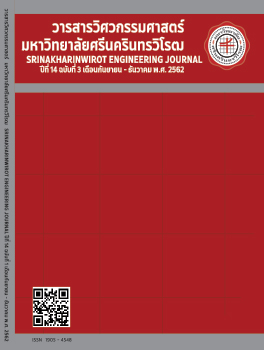Evaluation of sustainable urban drainage systems techniques approach for reducing peak runoff at Sukhumvit area in Bangkok, Thailand.
Main Article Content
Abstract
Urban Flooding has long been believed to be the results of natural phenomena which could be cited as heavy rainfall, tidal surges, and land subsidence. Urban flooding becomes more frequent as the population rapidly increasing, urbanization, unplanned development, and climate change. This phenomenon are not only damages lives and environment but also impacts of economy, health, social, and transportation. In urban areas, flooding is caused by several reasons: the rise of the water level in the river through the city high tides for coastal cities, poor operation of the drainage system, and poor maintenance, etc. Flood management requires an understanding of the causes and adaptation to take appropriate improvement by implementing sustainable urban drainage systems techniques (SUDS). Thus, it will be a decreased percentage of imperviousness in an urban area. In this study, SUDS solutions, such as green roofs, rainwater harvesting, pervious pavements, urban green space, are applied at representative inundated sub-catchments. The study was conducted in the Sukhumvit area, Bangkok, Thailand. The results show green roofs are the best performer for reducing peak runoff because it is applied to all kinds of buildings, either residential, commercial. Rainwater harvesting and pervious pavements require specific available space for application making their performance very unstable. The best performing overall is green roofs, followed by rainwater harvesting, pervious pavements, and urban green.
Article Details
Copyright belongs to Srinakharinwirot University Engineering Journal
References
[2] J. Leitão, S. Boonya-aroonnet, D. Prodanović and Č. Maksimović, "The influence of digital elevation model resolution on overland flow networks for modelling urban pluvial flooding", Water Science and Technology, vol. 60, no. 12, pp. 3137-3149, 2009. Available: 10.2166/wst.2009.754.
[3] N. Thanvisitthpon, S. Shrestha and I. Pal, "Urban Flooding and Climate Change", Environment and Urbanization ASIA, vol. 9, no. 1, pp. 86-100, 2018. Available: 10.1177/0975425317748532.
[4] L. Rossman, "Modeling Low Impact Development Alternatives with SWMM", Journal of Water Management Modeling, 2010. Available: 10.14796/jwmm.r236-11.
[5] J. Czemiel Berndtsson, "Green roof performance towards management of runoff water quantity and quality: A review", Ecological Engineering, vol. 36, no. 4, pp. 351-360, 2010. Available: 10.1016/j.ecoleng.2009.12.014.


